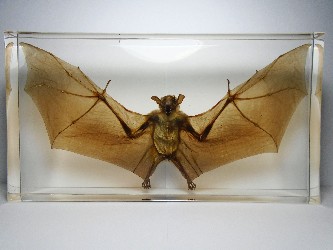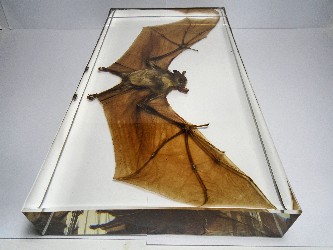


























LONG-TONGUED NECTAR BAT
CLEAR RESIN ENCAPSULATION
 |
 |
 |
 |
 |
 |
 |
 |
 |
 |
 |
 |
 |
 |
 |
 |
 |
 |
 |
 |
 |
 |
 |
 |
 |
 |
 |
|
Order Chiroptera
CLICK FOR DOWNLOAD (PDF) --------------------------
KINGDOM : Animalia
PHYLUM : Chordata
CLASS : Mammalia
ORDER : Chiroptera
FAMILY :Pteropodidae
SUBFAMILY :Macroglossinae
GENUS :Macroglossus
SPECIES :Macroglossus Minimus
--------------------
Order Mega/Micro chiroptera
|
LONG-TONGUED NECTAR BAT Long-tongued fruit bats are appropriately named due to their long tongue for extracting nectar and pollen from flowers. Macroglossus minimus feeds primarily on nectar and pollen, but occasionally also drinks the juices of soft fruit The flowers it mainly feeds on are from plants of the banana tree, the coconut tree & mangroves . The long-tongued fruit bat feeds by first landing on a flower and then using its long tongue to extract nectar or pollen from the flower. Long-tongued fruit bats, like many other pteropodids, have large eyes, and they orient visually. They do not use echolocation to locate their food source as do families in the suborder Microchiroptera. Distribution Its wide geographical range includes Thailand, Peninsular Malaysia, southern Philippines, Java, Borneo, New Guinea, the Solomon Islands, & northern Australia. In Borneo, it had been recorded from Kota Kinabalu, Sepilok, Sukau, & Tawau in Sabah; Bandar Seri Begawan in Brunei; Bario, Niah and Bako in Sarawak; Gunung Kenepi, Kutai, & Sungai Tengah in Kalimantan. M. minimus has not been recorded in flocks, which suggest they live in small group or alone. It feeds on nectar and pollen, which it can obtain from mangroves and banana flowers in Malaysia.Ecologically, the long-tongued nectar bat plays a major role as pollinator of many trees, including the families Bignoniaceae, Bombacaceae, Leguminosae, Musaceae, Myrtaceae, and Sonneratiaceae in peninsular Malaysia. M. minimus has been recorded at elevations up to 1000 m near coastal mangroves, in dipterocarp forests, and in lower montane forests. Biology Sexually active males have enlarged testes, & polyestrous females have a breeding period of 140 to 160 days. Estimates for the gestation period for M. minimus is approximately 120 days, lactation occurs for 60 to 70 days. In Negros Island, Philippines, females studies produced two or three young per year. The species reproduces aseasonally & synchronously in response to food abundance. Conservation Status The long-tongued fruit bat is not threatened due to its widespread distribution and the large number of individuals that exist in the wild. Also, this species can exist in a variety of habitats. However, there must be at least small area(s) that has been planted with trees that produce nectar or pollen on which it can feed.
|